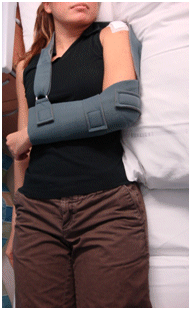Preparing for Shoulder Surgery
- Before Surgery
- After Surgery
- Pain Control
- Wounds, dressings, scars
- Follow Up
- Recovery following surgery
- Helpfull Tips after Surgery
- Do Nots
You will be advised by the hospital a few days before the admission date, the approximate time of arrival on the day of
surgery.
You should be nil by mouth for 6 hours before surgery, although you are allowed clear water up to 2 hours before surgery.
You should take your usual medications eg antihypertensive tablets on the morning of surgery with small sip of water.
Please take off any rings from your hands before coming to hospital. If the ring has been there for a long time and cannot be removed manually, then it must be cut off. The reason for this is that following any surgery to the upper extremity, the swelling is likely to accumulate in the hand and fingers and the blood circulation to the finger tips can be compromised if there is a tight ring present.
It is common to have the operated arm and sometimes even the hand to be swollen and puffy following surgery. This may last between days to weeks. There may also be some clear, pink or even red fluid coming from the surgical wounds, this is not infection or bleeding and merely represent the many litres of fluid pumped inside the shoulder during surgery. Fluid discharge is most common coming from the surgical wound at the front.
Although the arm is held in a sling, you should begin hand squeezing exercises and wrist movements immediately.
The amount of pain you may experience following the surgery will depend on what operation you had done. Generally speaking, for keyhole surgery, a degree of pain immediately following surgery is common but this improves considerably within a few days, to the extent that at 2 weeks from surgery, the majority of patients do not require regular pain killers.
To help with pain control immediately following surgery, there are broadly speaking two methods.
The first will involve a nerve root injection placed at the base of the neck, known as an interscalene block. This injection will numb the entire arm completely and patients often describe their arm as being ‘dead’ or ‘very heavy’. The effect typically lasts between12-24 hours and usually starts to wear off at around 5am. When the block starts to wear off, you will feel a tingling or sometimes light burning sensation before the normal sensation returns.
The other method would involve giving you pain killers such as morphine from time to time. In deciding between these two methods, it is really a personal choice and to be discussed with your anaesthetist on the day of surgery. Some patient prefer to wake up from surgery with a pain free but numb arm whilst others prefer to have a fully sensate arm and take pain killers if and when required.
When you go home, the best pain killers to take would be regular paracetamol and an anti-inflammatory such as ibuprofen or diclofenac which should be taken with food to avoid stomach irritation.
Please note that anti-inflammatory drugs cannot be used (are contraindicated) in the following cases:
- Allergy to aspirin or any NSAID
- During pregnancy
- During breast feeding
- On blood thinning agents (anticoagulants)
- Suffering from a defect of the blood clotting system (coagulation)
- Active peptic ulcer
- Asthma
- Kidney Impairment
- Heart Impairment
- Liver Impairment
It may be worthwhile stocking up on these medications before the operation as the hospital charges a fee for take home medications which is not recoverable with insurance companies.
Some doctors advise patients to take these pain killers on a regular basis initially for the first few days following surgery whilst others advise taking them as only on an “as needed” basis. This is a personal choice. It is worthwhile remembering that pain killers take 30-45 minutes to take effect and therefore it is best not to wait until you are in a lot of pain before taking them. Normally the post-operative pain should improve significantly after 7-10 days to the extent that most patients take pain killers only when required.
Tramadol can sometimes be used to for break through pain but a number of patients find the side effects of nausea and dizziness to be troublesome. I would advise against tramadol unless the pain is severe. A small dose of tramadol at night before going to bed can be useful for those with difficulty sleeping.
To minimise the risk of infection, the incisions and dressings must be kept dry for 2 weeks. The dressings applied immediately following surgery are sterile and do not need to be changed at all unless they become wet. Although most hospitals use waterproof dressings, my experience with them is that they are not 100% waterproof and therefore it is best to avoid directly showering on the wounds. Consider protecting the wounds with a large piece of cling film. There is usually one stitch per key hole and the stitches should be left in until your first appointment at 2 weeks post surgery.
Following surgery, I would normally like to see you at 2 weeks, 6-8 weeks, 3-4 months and sometimes 6 months. Depending on your condition, physiotherapy sometimes starts immediately following surgery and at the latest at 6 weeks. It is usually once a week initially, progressing to once every other week subsequently. Normally 6-10 sessions would be required. Your physiotherapist would be the best person to advise regarding the frequency of the treatment sessions which is best for your condition.
The time required for recovery following surgery will vary from person to person and depend on the severity of the condition and the surgery. The following is intended to be a guide only.
Driving after Surgery
Patients cannot drive until they are off all pain medications and completely out of the sling.
To operate the vehicle safely, you need to be able to get both hands behind the steering wheel and be able to move your hands freely on the steering wheel from the 9 to 3 o’clock position
Returning to Work
The period of time off work will depend on your condition and the type of work that you do. Generally, most patients can usually return to work within 3 weeks doing a ‘low demand’type of work. They will still have restrictions on lifting and overhead use. Patients with higher demand jobs or repetitive arm use need at least 6 weeks off. Any heavy labour with overhead lifting can require at least 3 months before returning to work.
Driving
You should not drive until your arm is out of the sling, your pain has subsided to the extent that you are not taking regular pain killers and that you can place your hands between 3 and 9 o’clock positions. Above all, you need to feel confident in your own ability to drive. If you feel that your ability to drive has been affected, you are required by law to contact the DVLA.
Prior to surgery, it would be worthwhile practising doing things with only one hand. Following surgery, the operated arm is likely to be out of action for a few weeks and it would be useful to prepare a few things in advance.
Food
- Soups, stews and casseroles or pre-cut meat and vegetables are generally easiest. Consider ready made meals
- Serve meals in a bowl. You can use the edge of the bowl to push food onto your spoon or fork.
- Scissors may help with chopping food.
- Move the items that you commonly use to low shelves in kitchen cupboards, fridges and freezers.
- To open a bottle or jar, put the jar in a drawer and lean against the drawer to hold it shut around the jar, then use a jar opener.
Washing
- Use an electric toothbrush
- Use flip-top toothpaste
Dressing
- Before undoing the straps on the sling, rest the arm on a pillow so the arm and shoulder remain supported in the same position as it was held in the sling.
- Always dress the operated arm first.
- When undressing, take the clothes off the operated arm last.
- Obtain a loose fitting top which is large enough to cover the operated arm with the sling. Alternatively, one could use an old T shirt and cut the side of the garment from axilla downwards.
- If you wear a belt, put the belt through the trousers loops before putting on the trousers.
- Most ladies with shoulder pain would have already learnt to
wear the bra from the front and swivel it backwards. Alternatively, you could try this gadget
www.buckinghamhealthcare.co.uk
Some patients have reported positive feedback after the use of the product. - Wear front opening clothes.
- Avoid shoelaces, wear shoes with velcro or elastic fastenings.
Bathing
- Avoid getting into the bath as it will be a real struggle to get up afterwards without using the operated arm to push up.
- A walk in shower cubicle can be most helpful and you can place a plastic chair in the cubicle and shower with the sling off. Use a part deflated beach ball or pillow in plastic bag to support the arm in same position as that held in the sling. For those without an overhead shower, you may find this gadget device useful: it is a suction shower arm and allows hands free showering www.buckinghamhealthcare.co.uk
- When drying, use a towelling bathrobe or drape a towel over the back of the chair and rub your back against the towel on the chair.
- Use flip-top or pump bottle soap and shampoo.
- Please remember to keep the surgical wounds dry and protected whilst washing. Waterproof dressings may be provided by the hospital to wear when you are washing, alternatively these can be bought from a chemist.
The recovery following shoulder surgery is usually straightforward and assuming the correct exercises are done at the correct time, recovery is predictable and uneventful. If you overuse your arm or do things that you should not do, this could disrupt the surgical repair. Listed below are a few things that one must not do:
DO NOT
- Push yourself out of a low chair/bath/toilet using the operated arm
- Let anyone pull you up by the operated arm
- Let anyone massage or manipulate your operated arm.
- Use your operated arm to lift anything heavy for 6 weeks. Generally speaking up to 2 lbs or a cup of tea is the limit.
Above all, do not lose contact with me. If there is any problem following surgery, I would like to know immediately. There is no need to go to Accident and Emergency or make an appointment with your GP, please contact me directly. If there is a problem which has arisen and is not related to the shoulder itself, I will try and put you in touch with the appropriate specialist eg cardiologist. During office hours, please ring my secretary on 01372 840836. Alternatively, for all other times, please ring the hospital ward where you had your surgery and I will contact you directly. It is highly likely that an urgent appointment can be arranged on the same day.
Wishing you all the best,
Francis Lam
I reckon being ill as one of the great pleasures of life, provided one is not too ill and is not obliged to work till
one is better.
Samuel Butler, The Way of All Flesh, 1903
Postoperative Physiotherapy
- General Notes
- Pendular Exercise
- Assisted Elevation
- Wall Climbing
- Lateral Stretch
- Hands Behind Back
- Pulleys
Here we have listed some of the common physiotherapy exercises for shoulder disorders. It is intended only as a reminder of the exercises as shown to you by your physiotherapist. These exercises may not be suitable for everyone as it would depend on the type of shoulder disorder that you have and the timescale following surgery. If there are any questions with regards to these exercises, we advise that you discuss them with your physiotherapist.
Pendular Exercise. Lean forward on a firm surface on your non operated arm and let the other arm swing freely first forwards and backwards, and then out to the side and across your body. 20 times in each direction. Repeat every 2 hours.
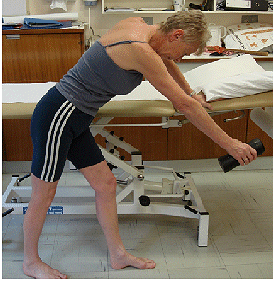
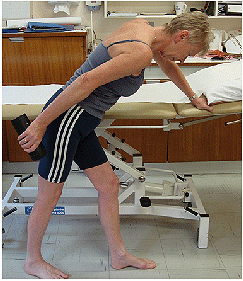
Assisted Elevation. Lying on your back with knees bent, clasp hands together and raise them slowly up over your head 20 times. Repeat 4 times a day. This can also be done standing.
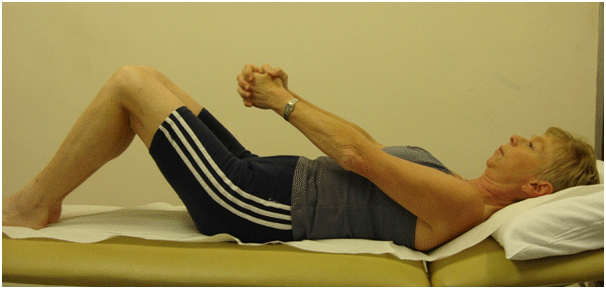
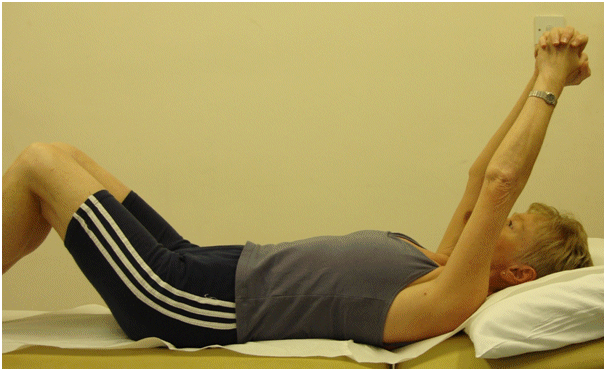
Wall Climbing. Face the wall and climb up with both arms as far as you can, making sure you do not lean backwards. Hold the stretch for 10 seconds and repeat 5 times 4 times a day.
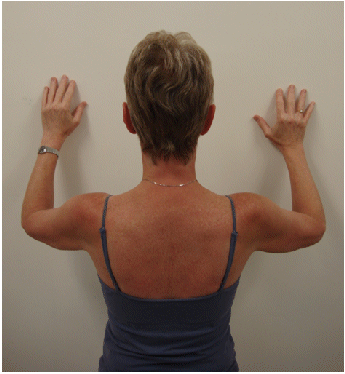
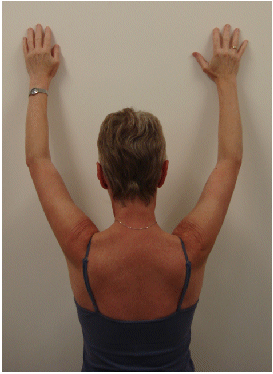
Stand sideways on to the wall on the operated side and walk your arm up the wall sideways, again do not lean backwards. Hold for 10 seconds and repeat 5 times, 4 times a day.
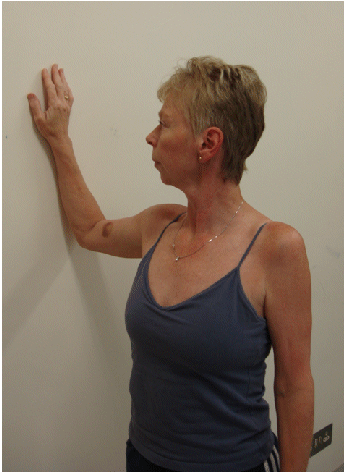
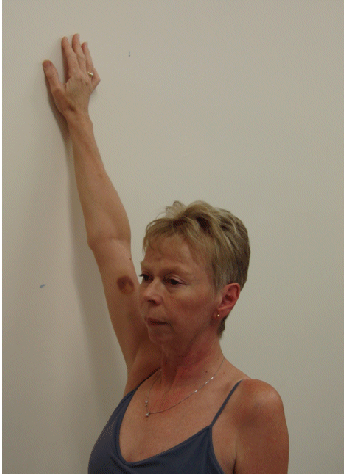
Lateral Stretch. Stand facing the end of a wall and place the palm of your hand on the wall with your elbow bent. Slowly turn your body away form your hand, keeping your upper arm in contact with your body. Repeat 10 times, 4 times a day.
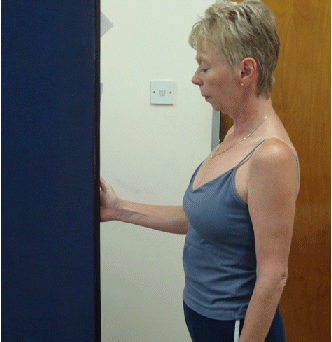
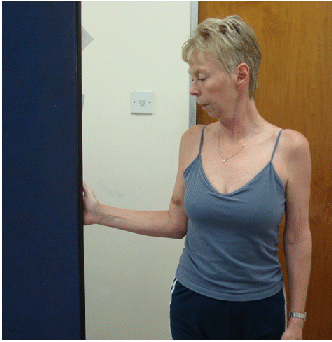
Hands Behind Back. Hold a light stick behind your back with both hands. Slowly take your hands away from your body and hold for 10 seconds. Repeat 10 times, 4 times a day.
Make sure you do not lean forwards
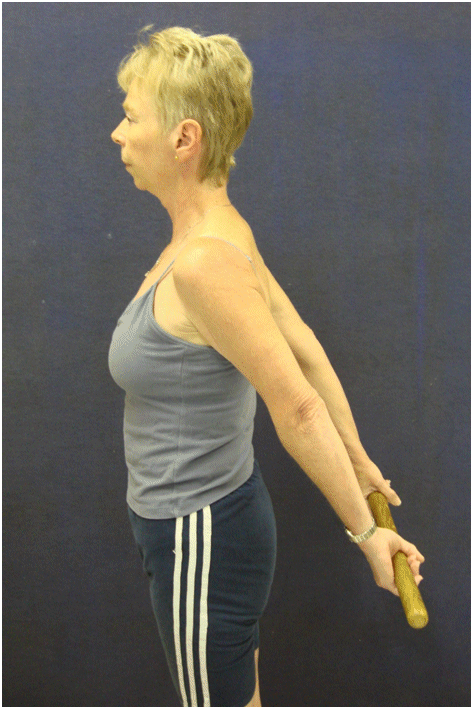
Pulleys. Put a light piece of rope over a coat hook on the back of a door and spend 5 minutes pulling your operated arm up and down. Try and increase the range of movement by pulling with your non-operated arm. Repeat 5 times a day.
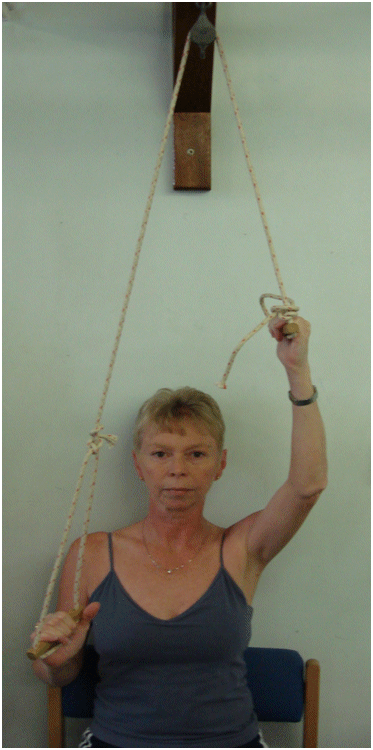
Polysling
- Immediately after surgery, it is often very difficult to apply and remove the sling safely using one arm. It is most desirable to have help from another person.
- For the first 2 weeks following surgery, it may be simplest to wear a loose fitting top which is large enough to cover the operated arm with the sling
- After the first 2 weeks, it may be possible to wear the sling on the outside of the clothes. This may be cosmetically better and also allow other people to know that they need to be careful with your arm.
The polysling has 4 components
- Sling and shoulder strap
- A strap with two ‘D’ loops worn around the wrist
- A short strap to close the sling near the elbow
- A long strap to be worn around the waist
How to wear the sling
- Place the operated arm into the sling carefully, using the other arm for support. If you are fitting the sling on your own without assistance, ensure that you are seated and your elbow bent to 90 degrees supported on a pillow.
- Close the sling by attaching the short strap with 2 D loops, approximately 5-7cms from the wrist.
- The strap with two D loops should be fixed onto the sling in such a way that one D loop is at the top and the other is on the inside of the sling against the body. CorrectIncorrect
- The second D loop must not be on the outside of the sling, otherwise this will inhibit wrist movements. Incorrect
- Attach the other short strap near the elbow.
- Place the shoulder strap over the neck and feed through the top D ring
- Adjust the length so that the hand is slightly higher than waist level.
- Attach the waist strap to the front of the strap, over the elbow.
- Pass the strap around the back of the waist.
- Feed through the D loop on the inside of the sling, and then attach the end back to itself with the Velcro fastening.
- If the sling is applied properly, you can use the hand only in front of the body and will not be able to reach behind and you will need to use the other hand for personal hygiene.
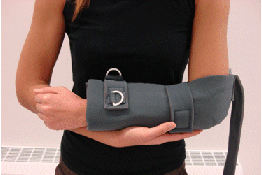
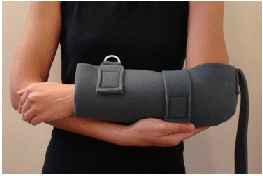

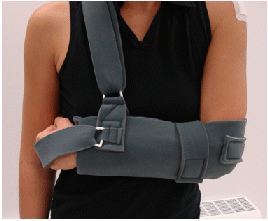

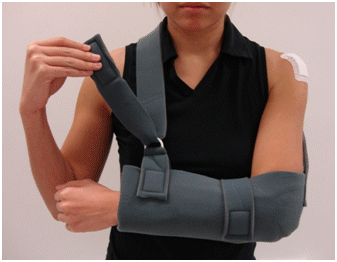

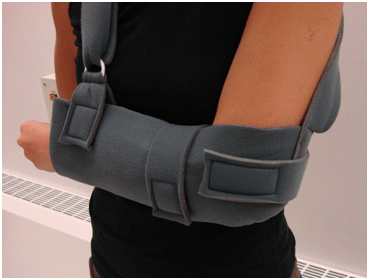

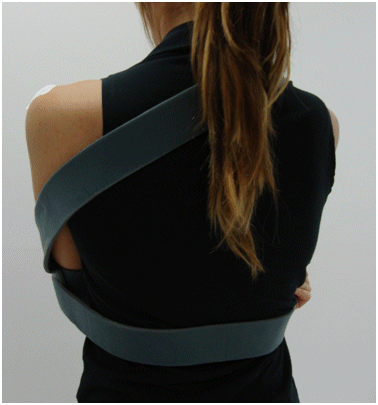

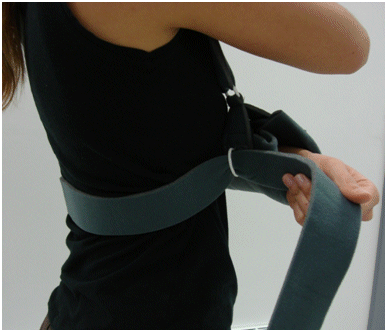

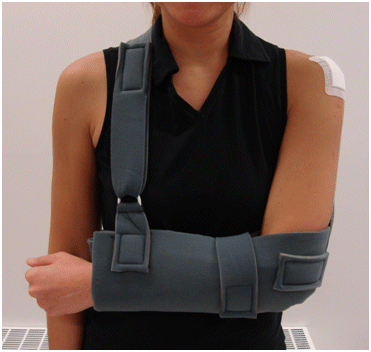
The period of time which you need to wear the sling after surgery will depend on the type of surgery you had and the quality of the soft tissues in the shoulder. Hence this will vary from person to person. I will be able to give a more precise time frame after surgery as this is tailored to your condition and the surgical treatment.
| Condition | Period of immobilisation in sling |
| Rotator cuff repair | 3 to 4 weeks, rarely 6 weeks |
| SLAP /labral repair | 2 to 3 weeks |
| Stabilisation | 3 to 6 weeks |
| Acromioclavicular joint repair | 6 weeks |
| Shoulder replacement | 3 weeks |
| Humeral fracture fixation | 4 to 6 weeks |
| Clavicle fracture fixation | 4 to 6 weeks |
| Frozen shoulder release | None, must mobilise immediately |
| Subacromial decompression alone | None, must mobilise immediately |
For the first few weeks following surgery, the sling should be kept on while you are in bed. It is generally safest to sleep on your back, and avoid sleeping on the side. If you find it difficult to position your arm whilst lying on your back, you may find it helpful to have a pillow under your operated arm for support. You may also find it more comfortable to sleep in a semi-reclined position. It is very common to have disturbed sleep for the first 3 weeks or so following surgery.

